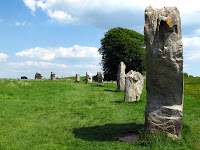Banbury is an hour
away, and the start of our circular drive. After driving through
Banbury, we stopped in nearby Wroxton, where Wroxton Abbey, once the
country home of Lord North who was Prime Minister at the time of the
American War of Independence, is now an American University. They
allow the public to wander in the grounds, so we enjoyed walking
around the immaculate grounds, surrounding the typical Elizabethan E
shaped house, detouring to the Dovecote and Obelisk.
From here the next stop
was Broughton Grange Gardens. We last visited in 2006, and were so
impressed, another visit before we leave the UK was the focus of the
day. The owners have been there since 1992, and developed the gardens
with the help of Tom Smith, in 2000.
Since then, Tom has gone on the win a gold prize at the Chelsea Flower Show six times. The whole look is like a giant Chelsea Flower Show garden. We were just as impressed as when we first visited. It's the sort of place to inspire anybody thinking of creating a garden.
Since then, Tom has gone on the win a gold prize at the Chelsea Flower Show six times. The whole look is like a giant Chelsea Flower Show garden. We were just as impressed as when we first visited. It's the sort of place to inspire anybody thinking of creating a garden.
Nearby is Broughton
Castle, and as it did not open until 2pm, we were forced to retrace
our route back to the attractive nearby town of North Newington. The
pub there is old and quaint, as are the staff. We enjoyed a leisurely
Ploughman's lunch, before heading back to the Castle.
This castle is amazing
to visit. Not only do they allow photographs inside, you feel as you
are a guest with the run of the whole house, from the Great Hall
where we entered, to the roof, where we could wander freely over part
of the lead roof.
The house has not been
spoilt and 'modernised' in the Victorian era, instead the
modernisation happened in the 16th century and since then has
remained largely unaltered. This means wonderful Jacobean ceilings
and a truly castle-like feel.
The garden is lovely
too, the sort of place to sit for a while, and we met the helpful,
friendly owner too, out working in the garden.
From here, we drove via
the Tyso villages, to Upton House. This National Trust property was
set up for a 1930's weekend away. A video made at an actual house
party, set the scene, along with the odd fur stole draped over
chairs, snooker available to play on the full-size billiard table,
and easy chairs to relax in while reading books in the library.
Nearby is the Edgehill
cliff-top castle Pub, dating from the 18th century, commemorating the
battle between Charles I and the Roundheads in 1642. The perfect
place to stop for coffee. The road descends rapidly to the village of
Radway, where the battle actually took place. It's quite a different
feel in this tranquil village today.
From here we crossed
the M40 and climbed uphill to a really magical place – Burton
Dassett. After crossing a cattle-stop at the top of the hill, an open
area with a grassed over 'craters of the moon' look, is ideal for
private picnics. The old grassed over iron quarry has an unreal feel.
Cars seem to be free to drive off road to park in amongst the grassy
hillocks, people had picnics set up around every corner. The church
is also very different The floor seems to follow the contour of the
hill, and definitely has a decided slope. Large windows with clear
glass and the plain walls, give a very open, European feel.
































































